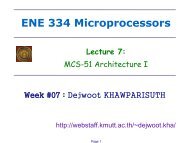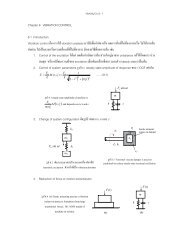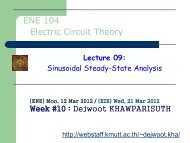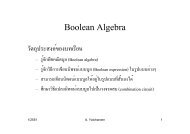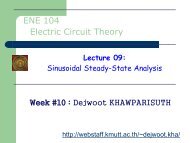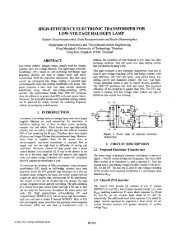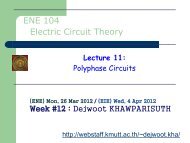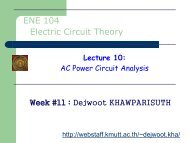Model-based fault-detection and diagnosis ... - web page for staff
Model-based fault-detection and diagnosis ... - web page for staff
Model-based fault-detection and diagnosis ... - web page for staff
You also want an ePaper? Increase the reach of your titles
YUMPU automatically turns print PDFs into web optimized ePapers that Google loves.
Table 4<br />
Fault-<strong>detection</strong> with observers <strong>for</strong> dynamic processes<br />
Another possibility is to generate an equation error (polynominal<br />
error) or an input error as in Table 6 (Gertler, 1998).<br />
The residuals depend in all cases only on the additive<br />
input <strong>fault</strong>s fu(t) <strong>and</strong> output <strong>fault</strong>s fy(t). The same procedure<br />
can be applied <strong>for</strong> multivariable processes by using a state<br />
space model, see Table 6.<br />
The derivatives of the signals can be obtained by state<br />
variable filters (Höfling, 1996). Corresponding equations<br />
exist <strong>for</strong> discrete-time <strong>and</strong> are easier to implement <strong>for</strong> the<br />
state space model. The residuals shown in Tables 5 <strong>and</strong> 6 left<br />
are direct residuals. If the parity equations are <strong>for</strong>mulated <strong>for</strong><br />
more than one input <strong>and</strong> one output, it becomes possible to<br />
generate structured residuals such that <strong>fault</strong>s do not<br />
influence all residuals. This improves the isolability of<br />
<strong>fault</strong>s (Gertler, 1998). For example, the components of<br />
matrix W <strong>for</strong> the state space model, Table 6 right, are<br />
selected such that, e.g., one measured variable has no impact<br />
on a specific residual. Parity equations are suitable <strong>for</strong> the<br />
R. Isermann / Annual Reviews in Control 29 (2005) 71–85 75<br />
<strong>detection</strong> <strong>and</strong> isolation of additive <strong>fault</strong>s. They are simpler to<br />
design <strong>and</strong> to implement than output observer-<strong>based</strong><br />
approaches <strong>and</strong> may be made to lead to the same results.<br />
2.5. Fault-<strong>detection</strong> with signal models<br />
Many measured signals y(t) show oscillations that are of<br />
either harmonic or stochastic nature, or both. If changes in<br />
these signals are related to <strong>fault</strong>s in the process, actuator or<br />
sensor, a signal analysis is a further source of in<strong>for</strong>mation.<br />
Especially <strong>for</strong> machine vibration, sensors <strong>for</strong> position, speed<br />
or acceleration are used to detect, <strong>for</strong> example, imbalance<br />
<strong>and</strong> bearing <strong>fault</strong>s (turbo machines), knocking (Diesel<br />
engines) or chattering (metal-grinding machines) (Kolerus,<br />
2000). But also signals from many other sensors, like<br />
electrical current, position, speed, <strong>for</strong>ce, flow <strong>and</strong> pressure,<br />
may show oscillations with a variety of higher frequencies<br />
than the usual process dynamic responses. The extraction of




